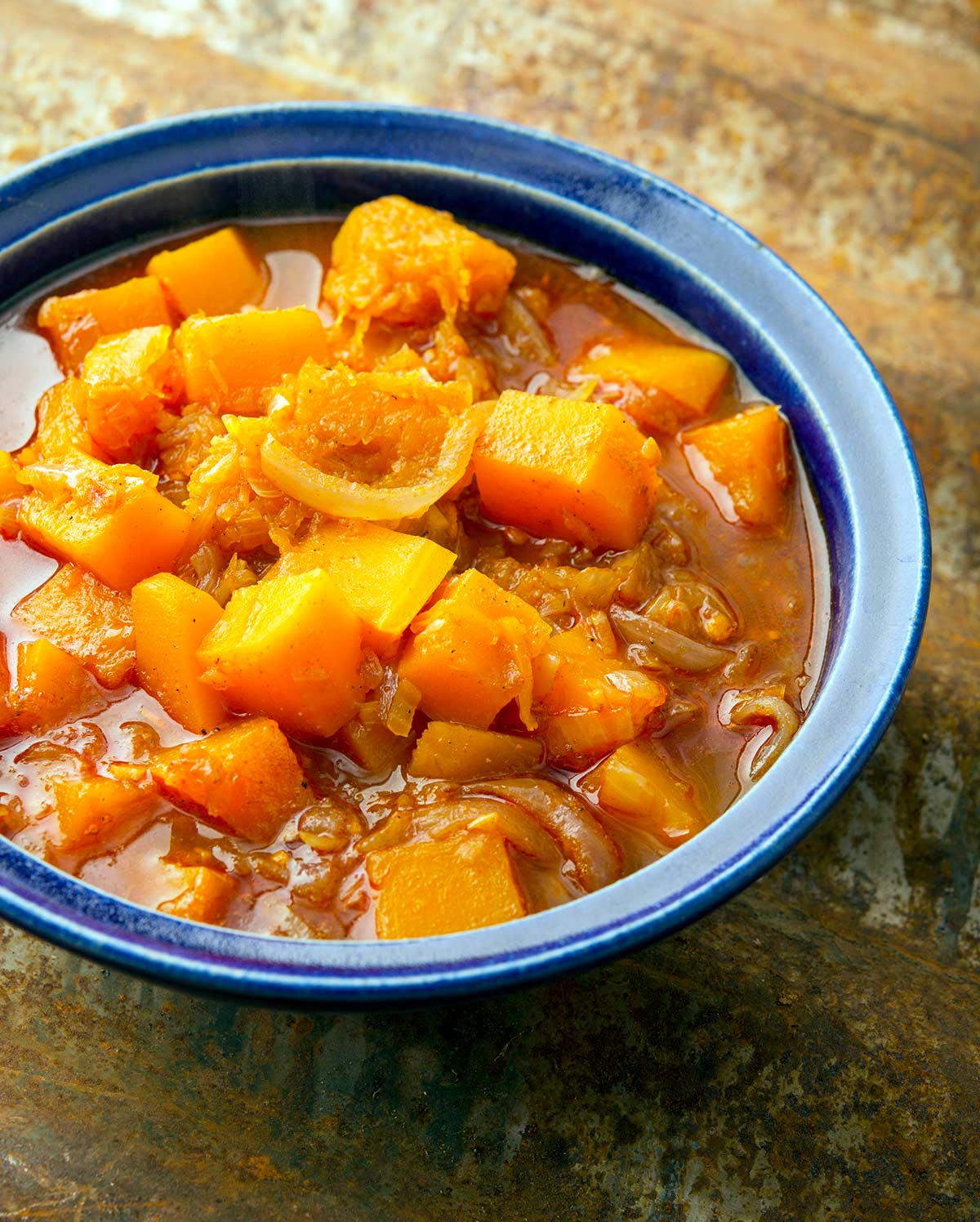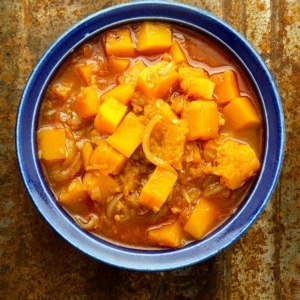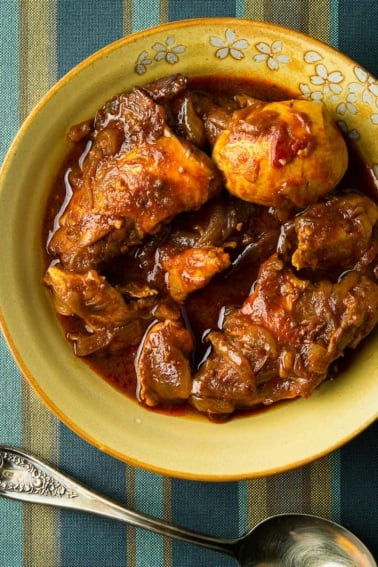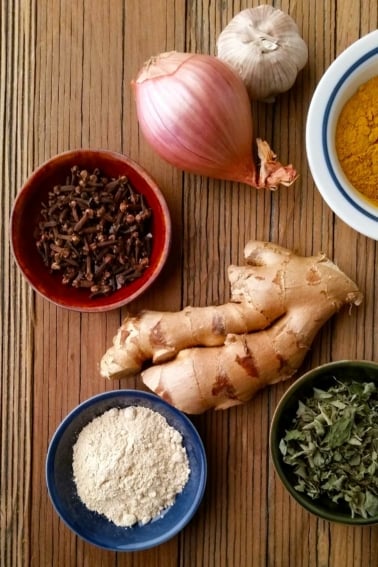As an Amazon Associate I earn from qualifying purchases.
I always grow butternut squash in my garden, and I often do so well I am at a loss as to how I might use all of them. Then I bought a fantastic cookbook by Yohannis Gebreysus called Ethiopia: Recipes and Traditions from the Horn of Africa. In it is a squash stew, but when you look closely, it is, essentially a butternut squash curry.
Some of you may know that I once worked in an Ethiopian restaurant, ages ago. We did not have a squash curry on the menu all the time, but my boss, a woman named Meselesh Ayele, would make one for autumn. I never did learn that recipe, but I was hoping this one in the book would be similar. It is.

Curry, you should know, is not just the province of India, although I’m pretty sure India is its origin. Ethiopia has traded with the Subcontinent for millennia, and their cuisines have benefited from that exchange.
One of the signature features of Indian cooking is their skill with vegetarian dishes. To my mind, India’s mastery of vegetarian cooking is only matched by the Chinese; I’d happily forego meat in either cuisine — not something I say lightly. This butternut squash curry is one of those quasi-vegetarian dishes. I say “quasi” because I used pheasant stock to make it; you of course could use whatever stock makes you happy, vegetarian or no. It just needs to be light in color.
There is one unusual ingredient you need for this dish: berbere. This is the signature spice mix of Ethiopia, and everyone makes it differently. I have my own recipe for berbere here, and you can buy the powder online from places like Penzey’s.
If you really want to make this butternut squash curry sing, cook it in niter kibbeh, the spiced, clarified butter of Ethiopia. (Here’s how to make it.) But if that’s too much for you, buy some ghee from the supermarket or just use regular butter.
I know, some of you are thinking, “can I add meat here?” Yes, you can. If it were me, I’d add white meat of some sort, or fish or seafood. Lobster or shrimp would be especially good, as would shredded poultry like pheasant or chicken, rabbit or quail.
You can serve this as is, like a stew, or with rice or bread. At the restaurant we served it with injera, the Ethiopian crepe-like flatbread made from a grain called teff.
I love cooking with butternut and other squash, and if you do too, you might like my recipes for butternut squash soup, squash gnocchi or squash spätzle.
Butternut Squash Curry
Ingredients
- 2 red onions, minced
- 1/4 cup niter kibbeh, ghee or unsalted butter
- 4 cloves garlic, chopped
- 1 tablespoon berbere spice mix
- 1/4 teaspoon cardamom (optional)
- 1/4 teaspoon fenugreek (optional)
- 2 pounds butternut squash, peeled, seeded and cut into chunks
- 2 cups chicken or vegetable stock
- Salt to taste
Instructions
- Add the onions to a large, heavy pot and turn the heat to medium-high. As they heat up, keep an eye on the onions, stirring them frequently so they don't stick. You want to sweat them without oil at this point. When they've lost some moisture and are wilting, now add the butter and start sautéing them. Cook over medium heat for about 5 minutes, stirring often.
- Add all the remaining ingredients except the stock, mix well and cook for about 5 minutes, again stirring often. Pour in the stock, bring it to a simmer and add salt to taste. Simmer, uncovered, until the squash is tender.
Nutrition
Nutrition information is automatically calculated, so should only be used as an approximation.





Bought some Berbere recently but hadn’t figured out how to use it yet. Tried it out with a kuri squash on hand and it was terrific.
We will try your pheasant recipe tomorrow. I appreciate the detail in that recipe. So many recipes on line are just “borrowed” from someone else and you don’t have any sense that it is the result of experience.
Could I add garbanzo beans?
Also plan on adding cubed berbere spiced chicken tenders pan fried in niter kebbeh.
Veronica: Absolutely.
Thanks for sharing recipe.
It was sooooo good!
Everyone loved it.
Thanks Hank! Langostino tails worked just fine for protein.
We made this last night….so good, so simple….just YUM!
Very cool. I first heard about berbere 2 weeks ago.
I have minimal room for spices in my tiny kitchen so maybe I can scarf some off of my friend and try this recipe sometime.
Got a butternut squash in my CSA yesterday and woke up to this recipe this morning. Perfect timing. Luckily we have a Penzy’s right down the street, too. Added shredded chicken thighs. Absolutely epic!
Made this tonight! Added ground turkey (farm raised as we didn’t harvest one during the fall season, but we enjoyed the hunt all the same) and chicken stock as well as squirrel stock (from squirrels we did harvest)!!!! Awesome!!!
Crappy day here in Minnesota so I thought it would be a good day for this recipe. I did make my own Berbere and cut back on the cayenne. My wife and I do not like the hot stuff!! Other wise it turned out awesome and am planning to make it again. I made enough Berbere for another batch so I have too!!
I’ve heard Curry cuisine is a bit spicey,a little on the hot side. To what degree is it,please? I’m sensitive to real spicey dishes.
Thank you,Ms. Harrison
Lila: This one is pretty spicy. Ethiopian food tends to be.
made Chicken Doro Wat another using Berbere it is spicy, but slow burn spicy. First you get a depth of flavour from the spices, especially the Berbere & the Cardamom, after that comes the spice. For me relatively mild but I’m used to spicy food. Hope you try it and are suprised. cooked this for friends to near universal praise, even from those who don’t like it “too spicy”.